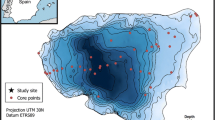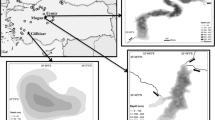Abstract
The minimum sieve mesh size for fossil chironomid analysis is usually set at 100 μm, to ensure adequate recovery of small species. Yet taking into account the labor intensity of sorting and identifying fossil chironomid remains, the large numbers of samples requiring processing in paleoclimate studies with high temporal resolution, and the increasing need to engage non-specialist analysts in this work, it seems appealing to sieve samples through a larger mesh size that would mainly retain easier-to-see, easier-to-extract and easier-to-identify fossil specimens. In this study we evaluated the influence of sieve mesh size on chironomid-based quantitative paleoenvironmental reconstructions in African lakes. We developed two chironomid-salinity calibration data sets based on either the >100 μm or >150 μm size fractions of surface-sediment fossil assemblages, and compared the performance of salinity-inference models derived from them. We find that, despite ∼35% additional fossil loss, restriction to >150 μm data did not appreciably affect individual taxon optima or tolerances, and resulted in only a modest reduction of mean taxon richness per lake. Parameters of statistical model performance were as good, or better than those of models based on the >100 μm data, albeit only after excluding two atypically dilute (<100 μS/cm) lakes from the calibration. Application of inference models based on >150 μm or >100 μm data to a 200-year fossil record from Lake Abiyata, Ethiopia, produced very similar trends, amplitudes and uncertainty ranges of inferred past salinity change. Restriction to >150 μm data reduced the mean fossil yield of core samples by ∼20% on average, i.e. fossil loss was markedly lower than in surface-sediment samples. Using the larger mesh size reduced sample processing time by up to 50%, partly by removing a significant proportion of visually obstructive organic debris, and partly by allowing a greater fraction of chironomid fossils to be identified directly in the sorting tray. The fraction of 1st instar group taxa in surface-sediment samples was reduced from 13% to 3%, increasing the mean taxonomic resolution of fossil assemblages, and thus their ecological specificity.



Similar content being viewed by others
References
Andreev A, Tarasov P, Schwamborn G, Ilyashuk B, Ilyashuk E, Bobrov A, Klimanov V, Rachold V, Hubberten HW (2004) Holocene paleoenvironmental records from Nikolay Lake, Lena River Delta, Arctic Russia. Palaeogeogr Palaeoclimatol Palaeoecol 209:197–217
Birks HJB (1995) Quantitative paleoenvironmental reconstructions. In: Maddy D, Brew JS (eds) Statistical modelling of quaternary Science data. Cambridge Quaternary Research Association, Cambridge, pp 161–254
Birks HJB (1998) Numerical tools in paleolimnology-progress, potentialities, and problems. J Paleolimnol 20:307–332
Brooks SJ (2000) Late-glacial fossil midge stratigraphies (Insecta: Diptera: Chironomidae) from the Swiss Alps. Palaeogeogr Palaeoclimatol Palaeoecol 159:261–279
Brooks SJ (2003) Chironomidae (Insecta: Diptera). In: MacKay RW, Birks HJB (eds) Global change in the Holocene. Arnold, London, pp 328–341
Brooks SJ, Bennion H, Birks HJB (2001) Tracing lake trophic history with a chironomid-total phosphorus inference. Freshw Biol 46:513–533
Brooks SJ, Birks HJB (2000a) Chironomid-inferred late-glacial and early-Holocene mean July air temperatures for Kråkenes Lake, western Norway. J Paleolimnol 23:77–89
Brooks SJ, Birks HJB (2000b) Chironomid-inferred late-glacial air temperatures at Whitrig Bog, south-east Scotland. J Quat Sci 15:759–764
Brooks SJ, Birks HJB (2001) Chironomid-inferred air temperatures from Lateglacial and Holocene sites in north-west Europe: progress and problems. Quat Sci Rev 20:1723–1741
Brooks SJ, Udachin V, Williamson BJ (2005) Impact of copper smelting on lakes in the southern Ural Mountains, Russia, inferred from chironomids. J Paleolimnol 33:229–241
Brundin L (1958) The bottom faunistical lake type system and its application to the southern hemisphere. Moreover a theory of glacial erosion as a factor of productivity in lakes and oceans. Verh Int Ver Theo Angew Limnol 13:288–297
Clerk S, Hall RI, Quinlan R, Smol JP (2000) Quantitative inferences of past hypolimnetic anoxia and nutrient levels from a Canadian Precambrian Shield lake. J Paleolimnol 23:319–336
Eggermont H, Verschuren D (2004) Subfossil Chironomidae from East Africa. 2. Chironomini and Tanytarsini. J Paleolimnol 32:413–455
Eggermont H, Heiri O, Verschuren D (2006) Fossil Chironomidae (Insecta: Diptera) as quantitative indicators of past salinity in African lakes. Quat Sci Rev 25:1966–1994
Eggermont H, Verschuren D (in press) Taxonomy and diversity of Afroalpine Chironomidae (Insecta: Diptera) on Mount Kenya and the Ruwenzori Mountains, East Africa. J Biogeogr
Gandouin E, Maasri A, Van Vliet-Lanoë B, Franquet E (2006) Chironomid (Insecta: Diptera) assemblages from a gradient of lotic and lentic waterbodies in river floodplains of France: A methodological tool for paleoecological applications. J Paleolimnol 35:149–166
Heinrichs ML, Walker IR, Mathewes RW (2001) Chironomid-based paleosalinity records in southern British Columbia, Canada: a comparison of transfer functions. J Paleolimnol 26:147–159
Heiri O, Lotter AF (2001) Effect of low count sums on quantitative environmental reconstructions: an example using subfossil chironomids. J Paleolimnol 26:343–350
Heiri O, Lotter AF (2003) 9000 years of chironomid assemblage dynamics in an Alpine lake: long-term trends, sensitivity to disturbance and resilience of the fauna. J Paleolimnol 30:273–289
Heiri O, Timmer W, Lotter AF (2004) Evidence for cooler European summers during periods of changing meltwater flux to the North Atlantic. Proc Natl Acad Sci USA 101:15285–15288
Heiri O, Millet L (2005) Reconstruction of Late Glacial summer temperatures from chironomid assemblages in Lac Lautrey (Jura, France). J Quat Sci 20:33–44
Hofmann W (1986) Chironomid Analysis. In: Berglund BE (ed) Handbook of holocene palaeoecology and palaeohydrology. J Wiley & Sons, Chichester, pp 715–728
Ilyashuk EA, Ilyashuk BP, Hammarlund D, Larocque I (2005) Holocene climatic and environmental changes inferred from midge records (Diptera : Chironomidae, Chaoboridae, Ceratopogonidae) at Lake Berkut, southern Kola Peninsula, Russia. Holocene 15:897–914
Lang B, Bedford AP, Richardson N, Brooks SJ (2003) The use of ultra-sound in the preparation of carbonate and clay sediments for chironomid analysis. J Paleolimnol 30:451–460
Langdon PG, Ruiz Z, Brodersen KP, Foster IDL (2006) Assessing lake eutrophication using chironomids: understanding the nature of community response in different lake types. Freshw Biol 51:562–577
Legesse D, Gasse F, Radakovitch O, Vallet-Coulomb C, Bonnefille R, Verschuren D, Gibert E, Barker P (2002) Environmental changes in a tropical lake (Lake Abijata, Ethiopia) during recent centuries. Palaeogeogr Palaeoclimat Palaeoecol 187:233–258
Levesque AJ, Mayle FE, Walker IR, Cwynar LC (1993) A previously unrecognized late glacial cold event in eastern North America. Nature 361:623–626
Levesque AJ, Cwynar LC, Walker IR (1997) Exceptionally steep north–south gradients in lake temperatures during the last deglaciation. Nature 385:423–426
Little J, Hall RI, Quinlan R, Smol JP (2000) Past trophic status and anoxia during eutrophication and remediation of Gravenhurst Bay, Ontaria: comparison of diatoms, chironomids, and historical records. Can J Fish Aquat Sci 57:333–341
Little J, Smol JP (2001) A chironomid-based model for inferring late-summer hypolimnetic oxygen in southeastern Ontario lakes. J Paleolimnol 26:259–270
Livingstone DM, Lotter AF, Walker IR (1999) The decrease in summer surface water temperature with altitude in Swiss Alpine lakes: a comparison with air temperature lapse rates. Arct Alp Res 31:341–352
Lotter AF, Birks HJB, Hofmann W, Marchetto A (1997) Modern diatom, cladoceran, chironomid, and chrysophyte cyst assemblages as quantitative indicators for reconstruction of past environmental conditions in the Alps. I. Climate J Paleolimnol 18: 395–420
Magurran AE (1998) Ecological diversity and its measure. Princeton University Press
Meriläinen JJ, Hynynen J, Palomäki A, Reinikainen P, Teppo A, Granberg K (2000) Importance of diffuse nutrient loading and lake level changes to the eutrophication of an originally oligotrophic boreal lake: a palaeolimnological diatom and chironomid analysis. J Paleolimnol 24:251–270
Palmer S, Walker IR, Heinrichs M, Hebda R, Scudder G (2002) Postglacial midge community change and Holocene palaeotemperature reconstructions near treeline, southern British Columbia (Canada). J Paleolimnol 28:469–490
Quinlan R, Smol JP (2001) Setting minimum head capsule abundance and taxa deletion criteria in chironomid-based inference models. J Paleolimnol 26:327–342
Quinlan R, Smol JP, Hall RI (1998) Quantitative inferences of past hypolimnetic anoxia in south-central Ontario lakes using fossil midges (Diptera: Chironomidae). Can J Fish Aquat Sci 55:587–596
Rosenberg SM, Walker IR, Mathewes RW, Hallett DJ (2004) Midge-inferred Holocene climate history of two subalpine lakes in southern British Columbia, Canada. Holocene 14:258–271
Sandman O, Meriläinen J, Simola H, Hynynen J, Lahtinen J, Marttila V, Reinikainen P (2000) Short-code paleolimnological investigation of Lake Pihlajavesi in the Saimaa Lake complex, eastern Finland: assessment of habitat quality of an endemic and endangered seal population. J Paleolimnol 24:317–329
Schnell RA, Raddum GG (1993) Past and present fauna of chironomids in remote mountain lakes. Preliminary results from the ALPE 1 project. In: Giussani G, Callieri C (eds) Strategies for Lake Ecosystems Beyond 2000, Proceedings, Stresa, pp 444–447
Seppä H, Nyman M, Korhola A, Weckström J (2002) Changes in treelines and alpine vegetation in relation to post-glacial climate dynamics in northern Fennoscandia based on pollen and chironomid records. J Quat Sci 17:287–301
Snowball I, Korhola A, Briffa KR, Koç N (2004) Holocene climate dynamics in Fennoscandia and the North Atlantic. In: Battarbee RW, Gasse F, Stickley CE (eds) Past climate variability through Europe and Africa. Kluwer, Dordrecht, pp 465–494
Sporka F, Stefkova E, Bitusik P, Thompson AR, Agusti-Panareda A, Appleby PG, Grytnes JA, Kamenik C, Krno I, Lami A, Rose N, Shilland NE (2002) The palaeolimnological analysis of sediments from high mountain lake Nizne Terianske pleso in the High Tatras (Slovakia). J Paleolimnol 28:95–109
Stephanova I, Ognjanova-Rumenova N, Hofmann W, Ammann B (2003) Late Glacial and Holocene environmental history of the Pirin Mountains (SW Bulgaria): a paleolimnological study of Lake Dalgoto (2310 m). J Paleolimnol 30:95–111
Talling JF, Talling IB (1965) The chemical composition of African lake waters. Int Rev Ges Hydrobiol 50:421–463
Velle G, Larsen J, Eide W, Peglar SM, Birks HJB (2005) Holocene environmental history and climate of Råtåsjøen, a low-alpine lake in south-central Norway. J Paleolimnol 33:129–153
Verschuren D (1994) Sensitivity of tropical-African aquatic invertebrates to short-term trends in lake level and salinity: a paleolimnological test at Lake Oloidien, Kenya. J Paleolimnol 10:253–263
Verschuren D, Cumming BF, Laird KR (2004) Quantitative reconstruction of past salinity variations in African lakes using fossil midges (Diptera: Chironomidae): assessment of inference models in space and time. Can J Fish Aquat Sci 61:986–998
Walker IR (1987) Chironomidae (Diptera) in paleoecology. Quat Sci Rev 6:29–40
Walker IR (2001) Midges: Chironomidae and related Diptera. In: Smol J, Birks HJB, Last W (eds) Tracking environmental change using Lake sediments: zoological indicators. Developments in Paleoenvironmental Research 4:43–66
Walker IR, Levesque AJ, Cwynar LC, Lotter AF (1997) An expanded surface-water palaeotemperature inference model for use with fossil midges from eastern Canada. J Paleolimnol 18:165–178
Walker IR, Mott RJ, Smol JP (1991) Allerod-Younger Dryas lake temperatures from midge fossils in Atlantic Canada. Science 253:1010–1012
Walker IR, Paterson CG (1985) Efficient separation of subfossil Chironomidae from lake sediments. Hydrobiologia 122: 189–192
Walker IR, Wilson S, Smol JP (1995) Chironomidae (Diptera): quantitative palaeosalinity indicators for lakes of western Canada. Can J Fish Aquat Sci 52:950–960
Acknowledgments
Lake sampling was conducted under Uganda NCST research clearance EC540 and Kenya government research permit MOES/001/11C to D.V., and sponsored by the Research Foundation of Flanders (FWO-Vlaanderen, Belgium) and Ghent University (Belgium). The Uganda Wildlife Authority and Kenya Wildlife Service are thanked for permission to sample lakes in national parks. We thank Thomas Bridgeman, Françoise Gasse, Anne-Christine Gouder de Beauregard, Karin Holmgren, Henry Lamb and David Ryves for providing additional surface-sediment samples from Ethiopia, Kenya, Uganda and Tanzania, and Françoise Gasse (CEREGE-CNRS, Aix-en-Provence, France) for making available the core material from Lake Abiyata. We further acknowledge discussions with Steve Brooks on the subject of this paper, and two anonymous referees for helpful comments. H.E. is a postdoctoral fellow with the Research Foundation of Flanders (FWO-Vlaanderen, Belgium).
Author information
Authors and Affiliations
Corresponding author
Rights and permissions
About this article
Cite this article
Verschuren, D., Eggermont, H. Sieve mesh size and quantitative chironomid paleoclimatology. J Paleolimnol 38, 329–345 (2007). https://doi.org/10.1007/s10933-006-9077-7
Received:
Accepted:
Published:
Issue Date:
DOI: https://doi.org/10.1007/s10933-006-9077-7




